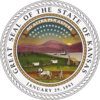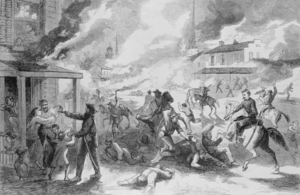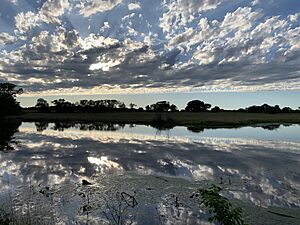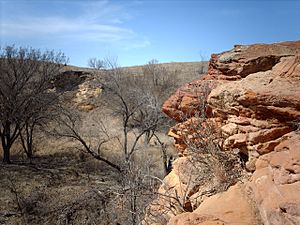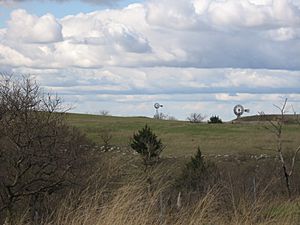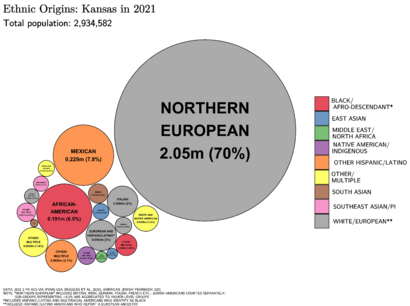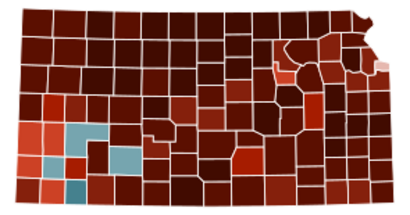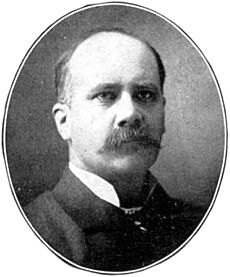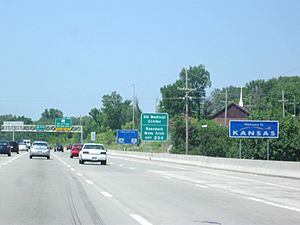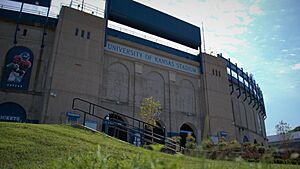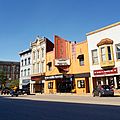Kansas facts for kids
Quick facts for kids
Kansas
|
|||||||||||||||
|---|---|---|---|---|---|---|---|---|---|---|---|---|---|---|---|
|
|||||||||||||||
| Nickname(s):
The Sunflower State (official);
The Wheat State; America's Heartland |
|||||||||||||||
| Motto(s): | |||||||||||||||
| Anthem: "Home on the Range" | |||||||||||||||
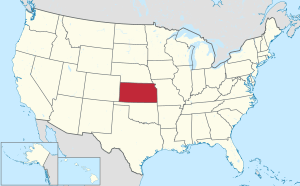
Location of Kansas within the United States
|
|||||||||||||||
| Country | United States | ||||||||||||||
| Before statehood | Kansas Territory | ||||||||||||||
| Admitted to the Union | January 29, 1861
Kansas Day
(34th) |
||||||||||||||
| Capital | Topeka | ||||||||||||||
| Largest city | Wichita | ||||||||||||||
| Largest county or equivalent | Johnson | ||||||||||||||
| Largest metro and urban areas | Kansas portion of Kansas City, MO-KS area | ||||||||||||||
| Legislature | Legislature | ||||||||||||||
| • Upper house | Senate | ||||||||||||||
| • Lower house | House of Representatives | ||||||||||||||
| Judiciary | Kansas Supreme Court | ||||||||||||||
| U.S. senators | Jerry Moran (R) Roger Marshall (R) |
||||||||||||||
| U.S. House delegation | 1: Tracey Mann (R) 2: Derek Schmidt (R) 3: Sharice Davids (D) 4: Ron Estes (R) (list) |
||||||||||||||
| Area | |||||||||||||||
| • Total | 82,278 sq mi (213,100 km2) | ||||||||||||||
| • Land | 81,759 sq mi (211,754 km2) | ||||||||||||||
| • Water | 520 sq mi (1,346 km2) 0.6% | ||||||||||||||
| Area rank | 15th | ||||||||||||||
| Dimensions | |||||||||||||||
| • Length | 210 mi (340 km) | ||||||||||||||
| • Width | 400 mi (640 km) | ||||||||||||||
| Highest elevation | 4,041 ft (1,232 m) | ||||||||||||||
| Lowest elevation
(Verdigris River at Oklahoma border)
|
679 ft (207 m) | ||||||||||||||
| Population
(2024)
|
|||||||||||||||
| • Total | |||||||||||||||
| • Rank | 34th | ||||||||||||||
| • Density | 34.9/sq mi (13.5/km2) | ||||||||||||||
| • Density rank | 41st | ||||||||||||||
| • Median household income | $70,300 (2023) | ||||||||||||||
| • Income rank | 34th (2021) | ||||||||||||||
| Demonym(s) | Kansan | ||||||||||||||
| Language | |||||||||||||||
| • Official language | English | ||||||||||||||
| Time zones | |||||||||||||||
| Majority of state | UTC−06:00 (Central) | ||||||||||||||
| • Summer (DST) | UTC−05:00 (CDT) | ||||||||||||||
| Greeley, Hamilton, Sherman, and Wallace counties | UTC−07:00 (Mountain) | ||||||||||||||
| • Summer (DST) | UTC−06:00 (MDT) | ||||||||||||||
| USPS abbreviation |
KS
|
||||||||||||||
| ISO 3166 code | US-KS | ||||||||||||||
| Traditional abbreviation | Kan., Kans. | ||||||||||||||
| Latitude | 37° N to 40° N | ||||||||||||||
| Longitude | 94° 35′ W to 102° 3′ W | ||||||||||||||
|
|||||||||||||||
Kansas (![]() i/ˈkænzəs/ KAN-zəss) is a state in the Midwestern part of the United States. It is a landlocked state, meaning it has no coastlines. Kansas shares borders with Nebraska to the north, Missouri to the east, Oklahoma to the south, and Colorado to the west. The state gets its name from the Kansas River, which was named after the Kansa Native American tribe. Topeka is the capital city, and Wichita is the largest city by population. However, the biggest urban area is the Kansas City, MO–KS metropolitan area, which spans both Kansas and Missouri.
i/ˈkænzəs/ KAN-zəss) is a state in the Midwestern part of the United States. It is a landlocked state, meaning it has no coastlines. Kansas shares borders with Nebraska to the north, Missouri to the east, Oklahoma to the south, and Colorado to the west. The state gets its name from the Kansas River, which was named after the Kansa Native American tribe. Topeka is the capital city, and Wichita is the largest city by population. However, the biggest urban area is the Kansas City, MO–KS metropolitan area, which spans both Kansas and Missouri.
For thousands of years, different Indigenous tribes lived in the area that is now Kansas. The first non-Native American settlement was at Fort Leavenworth in 1827. More people moved to Kansas in the 1850s. This was during a time of big arguments about slavery. When the U.S. government opened the area for settlement in 1854, people who wanted to end slavery (called Free-Staters) and those who supported it (from Missouri) fought over whether Kansas would be a free or slave state. This violent time was known as Bleeding Kansas. On January 29, 1861, Kansas officially joined the United States as a free state. This is why it has the unofficial nickname "The Free State."
After the Homestead Acts were passed in 1862, even more settlers arrived. The cattle trade in the 1870s brought famous figures from the Wild West to western Kansas. Today, Kansas is a very productive agricultural state. It grows a lot of wheat, corn, sorghum, and soybeans. Besides farming, Kansas also has a large aerospace industry, building airplanes and spacecraft parts. Kansas covers about 82,278 square miles (213,100 square kilometers), making it the 15th largest state. It is the 36th most populated state with about 2.9 million people. Residents of Kansas are called Kansans. The highest point in Kansas is Mount Sunflower, which is 4,039 feet (1,231 meters) tall.
Contents
- Kansas: Its Name and History
- Geography of Kansas
- How Kansas is Governed
- Kansas Cities and Communities
- Life Expectancy in Kansas
- Regions of Kansas
- Northeast Kansas: Major Cities and Universities
- South Central Kansas: The Air Capital
- Southeast Kansas: Coal Mining History
- Central and North-Central Kansas: Swedish Heritage and Presidential History
- Northwest Kansas: Wide Open Spaces
- Southwest Kansas: Cattle and Wind Farms
- Around the State: Unique Communities
- Kansas Population and People
- Kansas Economy and Jobs
- Transportation in Kansas
- Education in Kansas
- Kansas Culture and Entertainment
- Images for kids
- See also
Kansas: Its Name and History
What Does the Name "Kansas" Mean?
The name Kansas comes from the Algonquian word Akansa. This word described the Quapaw people, who settled in Arkansas around the 1200s. The part -kansa is named after the Kaw people, also known as the Kansa tribe. This tribe's name (natively kką:ze) is often said to mean "people of the (south) wind." However, this might not have been its first meaning.
Early History of Kansas
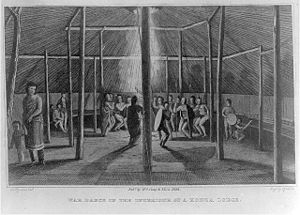
Samuel Seymour's 1819 drawing shows a Kansa lodge and dance. It is the oldest known drawing from Kansas.
|
Before Europeans arrived, Kansas was home to the Caddoan Wichita and later the Siouan Kaw people. Tribes in eastern Kansas usually lived in villages along rivers. Tribes in western Kansas moved around and hunted large herds of bison. The first European to visit Kansas was the Spanish explorer Francisco Vázquez de Coronado in 1541.
From 1763 to 1803, Kansas was part of Spanish Louisiana. During this time, Governor Luis de Unzaga encouraged trade and good relationships with Native Americans. Explorers like Antoine de Marigny traded along the Kansas River.
In 1803, most of Kansas became part of the United States through the Louisiana Purchase. Southwest Kansas was still part of Spain, Mexico, and the Republic of Texas until 1848. Then, these lands became part of the United States after the Mexican–American War. From 1812 to 1821, Kansas was part of the Missouri Territory. The Santa Fe Trail was an important route through Kansas from 1821 to 1880. It was used to transport goods from Missouri and silver and furs from Santa Fe, New Mexico. You can still see wagon ruts from the trail in the prairie today.
In 1827, Fort Leavenworth became the first lasting settlement for white Americans in the area. The Kansas–Nebraska Act became law on May 30, 1854. This law created the Nebraska Territory and Kansas Territory. It also opened the area for more white settlement. The Kansas Territory reached all the way to the Rocky Mountains. It included places like modern-day Denver, Colorado Springs, and Pueblo.
Bleeding Kansas and the Civil War Era
The first non-military settlers in Kansas Territory were people who wanted to end slavery. They came from Massachusetts and other areas. These "Free-Staters" founded the town of Lawrence. They wanted to stop slavery from spreading from nearby Missouri.
People from Missouri and Arkansas who supported slavery also moved into Kansas Territory. They tried to influence votes for Kansas to become a slave state. Before the American Civil War, these groups clashed. There were many small fights and conflicts. This period was called Bleeding Kansas. For example, John Brown led the Pottawatomie massacre in 1856.
Kansas joined the United States as a free state on January 29, 1861. It was the 34th state to become part of the Union.
Settlement and the Wild West in Kansas
The Homestead Acts of 1862 helped more people settle and develop farms in Kansas. After the Civil War, many soldiers built homes there. Many African Americans also saw Kansas as a place of freedom. Led by freedmen like Benjamin "Pap" Singleton, they started black communities in the state. They were called Exodusters because they left southern states in the late 1870s due to unfair treatment.
At the same time, the Chisholm Trail opened, starting the Wild West era in Kansas. Famous lawmen like Wild Bill Hickok worked in Fort Riley, Hays, and Abilene. Dodge City was home to Bat Masterson and Wyatt Earp, who were also lawmen there. The Dalton Gang robbed trains and banks across Kansas and the Southwest. They had a hideout in Meade. In one year, eight million cattle from Texas were loaded onto trains in Dodge City. They were sent east, earning Dodge the nickname "Queen of the Cowtowns."
Kansas in the 20th Century
In 1881, Kansas became the first U.S. state to ban all alcoholic drinks. This was due to demands from Methodists and other religious groups. This ban was lifted in 1948. Anti-alcohol activist Carrie Nation famously damaged her first saloon in Kiowa in 1900. In 1922, Ella Uphay Mowry was the first woman to run for governor in Kansas. She believed that one day a woman would be governor.
Kansas faced serious problems in the 1930s. The Great Depression and the Dust Bowl caused much environmental damage. Many people left southwestern Kansas to find better opportunities. World War II brought fast growth in aircraft manufacturing near Wichita. This area was called the Battle of Kansas. The aerospace industry is still a big part of Kansas's economy today.
Geography of Kansas

Kansas is surrounded by other states: Nebraska to the north, Missouri to the east, Oklahoma to the south, and Colorado to the west. The state has 105 counties and 628 cities. Butler County is the largest county by area. Kansas is located in the middle of the United States, about the same distance from the Pacific and Atlantic oceans. The exact middle point of the 48 connected states is in Smith County, near Lebanon. The geographic center of Kansas itself is in Barton County.
Kansas Land and Surface Features
The western two-thirds of Kansas are part of the Great Plains. This area is generally flat or gently rolling. The eastern third of the state has more hills and forests. The land gradually gets higher as you go from east to west. The lowest point is 684 ft (208 m) along the Verdigris River in Coffeyville. The highest point is Mount Sunflower at 4,039 ft (1,231 m), near the Colorado border. It's a common idea that Kansas is the flattest state. However, Kansas has a height difference of 3,360 ft (1,020 m). This makes it the 23rd flattest U.S. state when measured by its highest and lowest points.
Rivers Flowing Through Kansas
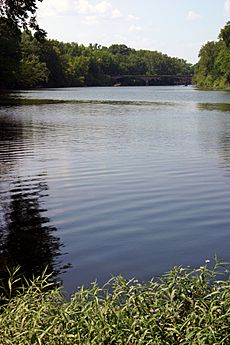
About 74 mi (119 km) of Kansas's northeastern border is formed by the Missouri River. The Kansas River (also called the Kaw) starts where the Smoky Hill and Republican rivers meet at Junction City. It flows for 170 mi (270 km) across northeastern Kansas and joins the Missouri River at Kansas City.
The Arkansas River begins in Colorado. It flows for almost 500 mi (800 km) through the western and southern parts of Kansas. Its smaller rivers, like the Little Arkansas, Ninnescah, and Cimarron, form the southern water system of the state.
Other important rivers in Kansas include the Saline and Solomon Rivers, which flow into the Smoky Hill River. The Big Blue, Delaware, and Wakarusa rivers flow into the Kansas River. The Marais des Cygnes River is a branch of the Missouri River. The Spring River is located between Riverton and Baxter Springs.
National Parks and Historic Sites in Kansas
The National Park Service protects several special places in Kansas:
- Brown v. Board of Education National Historic Site in Topeka
- Fort Larned National Historic Site in Larned
- Fort Scott National Historic Site in Bourbon County
- Nicodemus National Historic Site at Nicodemus
- Pony Express National Historic Trail
- Tallgrass Prairie National Preserve near Strong City
Plants and Animals of Kansas
Kansas is home to many different plants and animals. There are 238 rare animal species and 400 rare plant species. Some of these include the Smooth rockress plant and the Black-footed ferret animal.
Common animals you might see are Crows, Deer, Mice, Raccoons, and Prairie dogs. The state also has many types of grasses like Eastern Gama Grass, Prairie Dropseed, and Big Bluestem.
Kansas Climate and Weather Patterns

Kansas has three main climate types: humid continental, semi-arid steppe, and humid subtropical. The eastern two-thirds of the state has a humid continental climate. This means cool to cold winters and hot, often humid summers. Most rain falls in summer and spring.
The western third of Kansas has a semi-arid steppe climate. Summers are hot and generally less humid. Winters can change a lot between warm and very cold. This region gets about 16 inches (410 millimeters) of rain each year. Warm Chinook winds in winter can make western Kansas as warm as 80 degrees Fahrenheit (27 degrees Celsius).
The south-central and southeastern parts of Kansas, including the Wichita area, have a humid subtropical climate. Here, summers are hot and humid, winters are milder, and there is more rain. All three climates can be found across the state. Droughts and changing weather are common.
Temperatures in areas between U.S. Routes 83 and 81 often reach 90 °F (32 °C) or higher in June, July, and August. High humidity can make the heat index very dangerous, especially in cities like Wichita and Topeka.
Rainfall varies from about 47 inches (1,200 mm) in the southeast to about 16 inches (410 mm) in the southwest. Snowfall ranges from about 5 inches (130 mm) in the south to 35 inches (890 mm) in the far northwest. Kansas is one of the sunniest states in the country.
Kansas often experiences severe weather, especially in spring and early summer. Strong thunderstorms are common. Some of these can become supercell thunderstorms, which can produce tornadoes. Kansas has more than 50 tornadoes each year on average. These storms can also bring large hail, flash flooding, and strong winds.
The highest temperature ever recorded in Kansas was 121 °F or 49.4 °C on July 24, 1936, near Alton. The lowest was −40 °F (−40 °C) on February 13, 1905, near Lebanon.
| City | Jan | Feb | Mar | Apr | May | Jun | Jul | Aug | Sep | Oct | Nov | Dec |
|---|---|---|---|---|---|---|---|---|---|---|---|---|
| Concordia | 36/17 | 43/22 | 54/31 | 64/41 | 74/52 | 85/62 | 91/67 | 88/66 | 80/56 | 68/44 | 51/30 | 40/21 |
| Dodge City | 41/19 | 48/24 | 57/31 | 67/41 | 76/52 | 87/62 | 93/67 | 91/66 | 82/56 | 70/44 | 55/30 | 44/22 |
| Goodland | 39/16 | 45/20 | 53/26 | 63/35 | 72/46 | 84/56 | 89/61 | 87/60 | 78/50 | 66/38 | 50/25 | 41/18 |
| Topeka | 37/17 | 44/23 | 55/33 | 66/43 | 75/53 | 84/63 | 89/68 | 88/65 | 80/56 | 69/44 | 53/32 | 41/22 |
| Wichita | 40/20 | 47/25 | 57/34 | 67/44 | 76/54 | 87/64 | 93/69 | 92/68 | 82/59 | 70/47 | 55/34 | 43/24 |
How Kansas is Governed
Executive Branch: State Leadership
The executive branch of Kansas government has one main officer and five other elected officers. The governor and lieutenant governor are elected together. The attorney general, secretary of state, state treasurer, and state insurance commissioner are each elected separately.
Legislative Branch: Making Laws
The Kansas Legislature has two parts:
- The Kansas House of Representatives has 125 members who serve two-year terms.
- The Kansas Senate has 40 members who serve four-year terms.
Judicial Branch: State Courts
The state's court system is led by the Kansas Supreme Court. This court has seven judges. When a judge position is open, the Governor chooses one of three people suggested by the Kansas Supreme Court Nominating Commission. This commission has nine members: five Kansas lawyers chosen by other lawyers, and four members chosen by the governor.
Kansas Cities and Communities
In recent decades, many people have moved from rural areas to cities in Kansas. Most cities in the Midwest have fewer than 3,000 people. Hundreds have fewer than 1,000. One historian says Kansas has over 6,000 ghost towns and shrinking communities. At the same time, some towns in Johnson County (near Kansas City) are growing very fast.
| City | Population* | Growth rate** | Metro area | |
|---|---|---|---|---|
| 1 | Wichita | 397,532 | 3.97% | Wichita |
| 2 | Overland Park | 197,238 | 13.77% | Kansas City, MO-KS |
| 3 | Kansas City | 156,607 | 7.42% | Kansas City |
| 4 | Olathe | 141,290 | 12.25% | Kansas City |
| 5 | Topeka | 126,587 | −0.70% | Topeka |
| 6 | Lawrence | 94,934 | 8.32% | Lawrence |
| 7 | Shawnee | 67,311 | 8.20% | Kansas City |
| 8 | Lenexa | 57,434 | 19.18% | Kansas City |
| 9 | Manhattan | 54,100 | 3.48% | Manhattan |
| 10 | Salina | 46,889 | -1.71% | ‡ |
| 11 | Hutchinson | 40,006 | −4.93% | ‡ |
| 12 | Leavenworth | 37,351 | 5.96% | Kansas City |
| 13 | Leawood | 33,902 | 6.39% | Kansas City |
| 14 | Garden City | 28,151 | 5.60% | ‡ |
| 15 | Dodge City | 27,788 | 1.64% | ‡ |
| 16 | Derby | 25,625 | 15.65% | Wichita |
| 17 | Emporia | 24,139 | -3.12% | ‡ |
| 18 | Gardner | 23,287 | 21.77% | Kansas City |
| 19 | Prairie Village | 22,957 | 7.04% | Kansas City |
| 20 | Junction City | 22,932 | -1.80% | Manhattan |
| 21 | Hays | 21,116 | 2.95% | ‡ |
| 22 | Pittsburg | 20,646 | 2.04% | ‡ |
| 23 | Liberal | 19,825 | −3.41% | ‡ |
| 24 | Newton | 18,602 | −2.77% | Wichita |
| *2020 census **Growth rate 2010–2020 ‡Defined as a micropolitan area |
||||
Kansas has 627 incorporated cities. Cities are divided into three classes based on their population. A third-class city has fewer than 5,000 people. If it reaches over 2,000 people, it can become a second-class city. Second-class cities have fewer than 25,000 people. If they reach over 15,000, they can become a first-class city. First and second-class cities are separate from any township areas.
Life Expectancy in Kansas
People in Kansas generally live about as long as the national average. In 2013, men in Kansas lived about 76.6 years, and women lived about 81.0 years. Life expectancy has increased in Kansas since 1980.
Regions of Kansas
Northeast Kansas: Major Cities and Universities
The northeastern part of Kansas is home to over 1.5 million people. This area includes the Kansas City (Kansas side), Manhattan, Lawrence, and Topeka areas. Overland Park, a newer city, has the largest population and land area in Johnson County. It is home to Johnson County Community College.
Olathe is the county seat and has Johnson County Executive Airport. Olathe, Shawnee, De Soto, and Gardner are some of the fastest-growing cities. These cities are also along the old Santa Fe Trail route. Mission Hills has the highest average income among cities with at least one thousand residents.
Many colleges are in Northeast Kansas. These include Baker University in Baldwin City (the oldest university, founded in 1858) and Benedictine College in Atchison. MidAmerica Nazarene University is in Olathe, and Ottawa University is in Ottawa and Overland Park. Kansas City has Kansas City Kansas Community College and KU Medical Center. The KU Edwards Campus is in Overland Park. West of these cities, Lawrence is home to the University of Kansas, the state's largest public university, and Haskell Indian Nations University.
To the north, Kansas City has many different neighborhoods. It has attractions like the Kansas Speedway, Sporting Kansas City, and The Legends at Village West shopping center. Nearby, Bonner Springs is home to the Providence Medical Center Amphitheater and the annual Kansas City Renaissance Festival. Further north along the Missouri River, Lansing has the state's first maximum-security prison. Historic Leavenworth, founded in 1854, was the first city in Kansas to be officially recognized. North of Leavenworth, Fort Leavenworth is the oldest active Army base west of the Mississippi River. The city of Atchison was an early trading center and is known as the birthplace of Amelia Earhart.
To the west, nearly a quarter million people live in the Topeka area. Topeka is the state capital. It is home to Washburn University and Washburn Institute of Technology. This historic city was built where the old Oregon Trail crossed the Kansas River. Westward along Interstate 70 and the Kansas River is Junction City. It has historic limestone buildings and is near Fort Riley, home to the U.S. Army's 1st Infantry Division. A short distance away, Manhattan is home to Kansas State University. This is the second-largest public university in the state and the nation's oldest land-grant university, started in 1863. South of the campus, Aggieville is the state's oldest shopping district, dating back to 1889.
South Central Kansas: The Air Capital
The Wichita metropolitan area in south-central Kansas has over 600,000 people. Wichita is the largest city in the state by both land area and population. It is known as 'The Air Capital' because it is a major center for aircraft manufacturing. Wichita State University is also located here. Before it was 'The Air Capital', Wichita was a "Cowtown" for cattle drives. Wichita is growing fast, and its suburbs like Goddard, Andover, and Derby are also growing quickly.
Wichita was one of the first cities to use a city commissioner and city manager government system. It is also home to the nationally recognized Sedgwick County Zoo.
Up the Arkansas River from Wichita is Hutchinson. This city is built on one of the world's largest salt deposits. It also has the world's largest wheat elevator. Hutchinson is home to the Kansas Cosmosphere and Space Center and the Kansas State Fair. North of Wichita along Interstate 135 is Newton. This city was once the end of the Santa Fe Railroad and a starting point for the Chisholm Trail. To the southeast of Wichita are Winfield and Arkansas City. These cities have historic buildings and the Cherokee Strip Museum. The town of Udall was hit by the deadliest tornado in Kansas on May 25, 1955. It killed 80 people.
Southeast Kansas: Coal Mining History
Southeast Kansas has a special history, especially in its coal-mining areas. Pittsburg in Crawford County is the largest city in this region. It is home to Pittsburg State University. Nearby, Frontenac was the site of the worst mine disaster in the state in 1888, where 47 miners died. "Big Brutus", a huge electric shovel, is located near West Mineral. Historic Fort Scott has a restored fort and a national cemetery.
Central and North-Central Kansas: Swedish Heritage and Presidential History
Salina is the largest city in central and north-central Kansas. South of Salina is the small city of Lindsborg. This town is known for its many Dala horses and has a distinct Swedish style in its buildings and decorations. To the east along Interstate 70, the historic city of Abilene was formerly a trailhead for the Chisholm Trail and was the boyhood home of President Dwight D. Eisenhower. His Presidential Library and the tombs of his family are located there. To the west is Lucas, known as the Grassroots Art Capital of Kansas.
Northwest Kansas: Wide Open Spaces

Westward along the Interstate, Russell marks the beginning of sparsely populated northwest Kansas. It was the home base for former U.S. Senator Bob Dole. The city of Hays is home to Fort Hays State University and the Sternberg Museum of Natural History. It is the largest city in the northwest with about 20,000 people.
Two other important landmarks are in smaller towns in Ellis County. The "Cathedral of the Plains" is near Victoria. The childhood home of Walter Chrysler (who founded Chrysler car company) is in Ellis. West of Hays, the population becomes much smaller. Only two towns have more than 4,000 people: Colby and Goodland.
Southwest Kansas: Cattle and Wind Farms
Dodge City, famously known for the cattle drive days of the late 19th century, was built along the old Santa Fe Trail route. The city of Liberal is located along the southern Santa Fe Trail route. The first wind farm in the state was built east of Montezuma. Garden City has the Lee Richardson Zoo.
Around the State: Unique Communities
Emporia is located midway between Kansas City, Topeka, and Wichita. It is in the heart of the Bluestem Region of the Flint Hills. Emporia has several nationally registered historic places and is the home of Emporia State University, well known for its Teachers College. It was also the home of newspaper writer William Allen White.
Kansas Population and People
Population Growth and Distribution
In 2019, the population of Kansas was about 2,913,314. This was a 2.11% increase since the 2010 census. This growth comes from more births than deaths, and people moving to Kansas from other countries. However, more people moved out of Kansas to other U.S. states than moved in. In 2020, the population was 2,937,880.
In 2018, most immigrants to Kansas came from Mexico, India, Vietnam, Guatemala, and China.
Kansas has about 52.9 people per square mile. The center of population for Kansas is in Chase County, near Strong City.
Farming in Kansas often uses large machines and fewer people. This causes people to move from rural areas to cities.
| Historical population | |||
|---|---|---|---|
| Census | Pop. | %± | |
| 1860 | 107,206 | — | |
| 1870 | 364,399 | 239.9% | |
| 1880 | 996,096 | 173.4% | |
| 1890 | 1,428,108 | 43.4% | |
| 1900 | 1,470,495 | 3.0% | |
| 1910 | 1,690,949 | 15.0% | |
| 1920 | 1,769,257 | 4.6% | |
| 1930 | 1,880,999 | 6.3% | |
| 1940 | 1,801,028 | −4.3% | |
| 1950 | 1,905,299 | 5.8% | |
| 1960 | 2,178,611 | 14.3% | |
| 1970 | 2,246,578 | 3.1% | |
| 1980 | 2,363,679 | 5.2% | |
| 1990 | 2,477,574 | 4.8% | |
| 2000 | 2,688,418 | 8.5% | |
| 2010 | 2,853,118 | 6.1% | |
| 2020 | 2,937,880 | 3.0% | |
| 1910–2020 | |||
Diversity in Kansas: Race and Ethnicity
According to 2021 estimates, the population of Kansas is mostly White American, non-Hispanic (74.7%). Other groups include Hispanic or Latino (12.7%), Black or African American (6.2%), and Asian (3.2%). Many people also identify with two or more races (3.3%).
| Racial composition | 1990 | 2000 | 2010 | 2020 |
|---|---|---|---|---|
| White | 90.1% | 86.1% | 83.8% | 75.6% |
| Black | 5.8% | 5.8% | 5.9% | 5.7% |
| Asian | 1.3% | 1.7% | 2.4% | 2.9% |
| Native | 0.9% | 0.9% | 1.0% | 1.1% |
| Native Hawaiian and other Pacific Islander |
– | – | 0.1% | 0.1% |
| Other race | 2.0% | 3.4% | 3.9% | 4.9% |
| Two or more races | – | 2.1% | 3.0% | 9.5% |
The largest ancestry groups in Kansas are German (33.75%), Irish (14.4%), and English (14.1%). German descendants are common in northwest and northeast Kansas. Many African Americans in Kansas are descendants of the Exodusters. These were newly freed black people who moved to Kansas after the Civil War.
Kansas also has a growing Asian community. Since 1965, more Asian families have moved to Kansas from countries like the Philippines, China, Korea, India, and Vietnam.
- Birth data
| Race | 2013 | 2014 | 2015 | 2016 | 2017 | 2018 | 2019 | 2020 | 2021 | 2022 |
|---|---|---|---|---|---|---|---|---|---|---|
| White: | 34,178 (88.0%) | 34,420 (87.7%) | 34,251 (87.5%) | ... | ... | ... | ... | ... | ... | ... |
| > non-Hispanic White | 28,281 (72.8%) | 28,504 (72.7%) | 28,236 (72.1%) | 26,935 (70.8%) | 25,594 (70.1%) | 25,323 (69.8%) | 24,549 (69.4%) | 23,663 (68.8%) | 24,056 (69.3%) | 23,669 (68.8%) |
| Black | 2,967 (7.6%) | 3,097 (7.9%) | 3,090 (7.9%) | 2,543 (6.7%) | 2,657 (7.3%) | 2,575 (7.1%) | 2,458 (6.9%) | 2,412 (7.0%) | 2,316 (6.7%) | 2,208 (6.4%) |
| Asian | 1,401 (3.6%) | 1,359 (3.5%) | 1,483 (3.8%) | 1,299 (3.4%) | 1,255 (3.4%) | 1,228 (3.4%) | 1,216 (3.4%) | 1,146 (3.3%) | 1,031 (3.0%) | 1,055 (3.1%) |
| American Indian | 293 (0.7%) | 347 (0.9%) | 330 (0.8%) | 173 (0.5%) | 248 (0.7%) | 217 (0.6%) | 214 (0.6%) | 162 (0.5%) | 183 (0.5%) | 163 (0.5%) |
| Hispanic (of any race) | 6,143 (15.8%) | 6,132 (15.6%) | 6,300 (16.1%) | 6,298 (16.5%) | 5,963 (16.3%) | 5,977 (16.5%) | 6,071 (17.2%) | 5,970 (17.4%) | 6,122 (17.6%) | 6,309 (18.3%) |
| Total Kansas | 38,839 (100%) | 39,223 (100%) | 39,154 (100%) | 38,053 (100%) | 36,519 (100%) | 36,261 (100%) | 35,395 (100%) | 34,376 (100%) | 34,705 (100%) | 34,401 (100%) |
Languages Spoken in Kansas
English is the most common language spoken in Kansas. In 2000, 91.3% of people spoke only English at home. Spanish is spoken by 5.5% of the population, German by 0.7%, and Vietnamese by 0.4%.
Religion in Kansas
Religion in Kansas (2022), per PRRI Christianity (74%) Irreligion (23%) Unitarian Universalism (1%) New Age (1%)
Most adults in Kansas are Christian (74% in 2022). This includes Protestants (59%), Catholics (13%), and Mormons (2%). About 23% of the population has no religious affiliation.
Topeka, the capital, is important in the history of Pentecostalism. It was where Charles Fox Parham's Bethel Bible College was located. In 1901, people there first claimed to speak in tongues as a sign of a spiritual experience. Topeka was also home to Reverend Charles Sheldon, who wrote In His Steps. The famous question "What would Jesus do?" came from one of his sermons.
Kansas also has the second oldest Baha'i community outside of Egypt. It started in Enterprise, KS, in 1897.
Kansas Economy and Jobs
Kansas's total economic output was $226 billion in 2023. The average income per person was $63,732, and the average household income was $68,925.
In 2016, there were 1,184,710 jobs in Kansas. The Kansas City MO-KS MSA had 468,400 non-farm jobs. The Wichita, KS MSA had 297,300 non-farm jobs.
Almost 90% of Kansas's land is used for agriculture. The state produces cattle, sheep, wheat, sorghum, soybeans, corn, and salt. In 2018, Kansas had 59,600 farms. The average farm was about 770 acres.
Wheat is the most important crop. Eastern Kansas is part of the Grain Belt, a major grain-producing area. About 40% of all winter wheat in the U.S. is grown in Kansas. Most of this is hard red winter wheat.
Kansas also produces transportation equipment, aircraft, processed foods, and chemical products.
| Rank | Business | Employees | Location | Industry |
|---|---|---|---|---|
| 1 | Spirit AeroSystems | 12,000 | Wichita | Aviation |
| 2 | Sprint Corporation | 7,600 | Overland Park | Telecommunications |
| 3 | Textron Aviation | 6,812 | Wichita | Aviation |
| 4 | General Motors | 4,000 | Kansas City | Automotive manufacturing |
| 5 | Bombardier Aerospace | 3,500 | Wichita | Aviation |
| 6 | Black & Veatch | 3,500 | Overland Park | Engineering consulting |
| 7 | National Beef | 3,500 | Liberal | Food products |
| 8 | Tyson Foods | 3,200 | Holcomb | Food products |
| 9 | Performance Contracting | 2,900 | Lenexa | Roofing and siding |
| 10 | National Beef | 2,500 | Dodge City | Food products |
The aerospace industry is very important to Kansas. Several large aircraft companies have factories in Wichita and Kansas City. These include Spirit AeroSystems, Bombardier Aerospace (which makes LearJets), and Textron Aviation.
Major companies with headquarters in Kansas include Garmin (in Olathe), YRC Worldwide (Overland Park), Payless Shoes (in Topeka), and Koch Industries (in Wichita).
Kansas also has three large military bases: Fort Leavenworth (Army), Fort Riley (Army), and McConnell Air Force Base (Air Force). About 25,000 soldiers and airmen are stationed at these bases. They also employ about 8,000 civilian workers.
Energy Production in Kansas
Kansas has many renewable energy sources. It is a top producer of wind energy in the U.S. In 2019, it had about 6,100 Megawatts of power from nearly 3,200 wind turbines. Wind generated 41% of the state's electricity. Kansas is also a leading producer of renewable ethanol and biodiesel fuels.
Kansas is ranked eighth in U.S. petroleum (oil) extraction. Oil production has slowly decreased as reserves are used up. However, higher oil prices have made some oil recovery methods more profitable.
Kansas is also ranked eighth in U.S. natural gas production. This has also decreased since the mid-1990s as the Hugoton Natural Gas Field has been used.
Taxes in Kansas
The Kansas Department of Revenue collects taxes. The state sales tax in Kansas is 6.15%. Many cities and counties have an additional local sales tax. This means Kansas has many different sales tax rates, from 6.5% to 11.5%. Groceries are also subject to sales tax.
Transportation in Kansas
Highways and Roads
Kansas is served by two Interstate highways with one beltway, two spur routes, and three bypasses, with over 874 miles (1,407 km) in all. The first section of Interstate in the nation was opened on Interstate 70 (I-70) just west of Topeka on November 14, 1956.
- I-70 goes east-west, connecting to Denver, Colorado, and Kansas City, Missouri. Cities along I-70 include Colby, Hays, Salina, Junction City, Topeka, Lawrence, Bonner Springs, and Kansas City.
- I-35 goes north-south, connecting to Oklahoma City, Oklahoma, and Des Moines, Iowa. Cities along I-35 include Wichita, El Dorado, Emporia, Ottawa, and Kansas City (and suburbs).
Some Interstate routes are connections between the two main routes. I-135 connects I-35 at Wichita to I-70 at Salina. I-335 connects I-35 at Emporia to I-70 at Topeka. I-335 and parts of I-35 and I-70 form the Kansas Turnpike. Bypasses include I-470 around Topeka, I-235 around Wichita, and I-670 in downtown Kansas City. I-435 is a beltway around the Kansas City metropolitan area while I-635 bypasses through Kansas City.
U.S. Route 69 (US-69) travels south to north, from Oklahoma to Missouri. The highway passes through the eastern section of Kansas, traveling through Baxter Springs, Pittsburg, Frontenac, Fort Scott, Louisburg, and the Kansas City area.
Kansas also has the country's third largest state highway system after Texas and California. This is because of the high number of counties and county seats (105) and their intertwining.
In January 2004, the Kansas Department of Transportation (KDOT) announced the new Kansas 511 traveler information service. By dialing 511, callers will get access to information about road conditions, construction, closures, detours and weather conditions for the state highway system. Weather and road condition information is updated every 15 minutes.
Interstate Highways in Kansas
U.S. Routes in Kansas
Airports in Kansas
The state's only major commercial airport is Wichita Dwight D. Eisenhower National Airport. Manhattan Regional Airport in Manhattan offers daily flights to major cities. Most air travelers in northeastern Kansas fly out of Kansas City International Airport, located in Platte County, Missouri.
For those in the far western part of the state, Denver International Airport is a popular option. Connecting flights are also available from smaller Kansas airports in Dodge City, Garden City, Hays, Hutchinson, Liberal, or Salina.
Dotted across the state are smaller regional and municipal airports, including the Lawrence Municipal Airport.
Rail Travel in Kansas
Up through the mid-20th century, railroads connected most cities in Kansas. During World War II, some less profitable lines were removed for scrap metal. Then, more lines were reduced as cars and trucks became more common.
For passenger service, the Southwest Chief Amtrak route runs through the state. It travels from Chicago, Illinois, to Los Angeles, California. Stops in Kansas include Lawrence, Topeka, Newton, Hutchinson, Dodge City, and Garden City.
For freight service, there are three large railroads in Kansas: BNSF, Union Pacific, and Kansas City Southern. There are also many smaller railroads.
Education in Kansas
Education in Kansas is governed at the primary and secondary school level by the Kansas State Board of Education. The state's public colleges and universities are supervised by the Kansas Board of Regents.
Kansas Culture and Entertainment
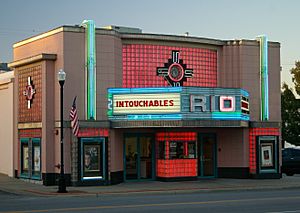
Music from Kansas
The rock band Kansas was formed in the state capital of Topeka. Several of the band's members were from there.
Joe Walsh, guitarist for the famous rock band the Eagles, was born in Wichita. Danny Carey, drummer for the band Tool, was raised in Paola.
Singers from Kansas include Leavenworth native Melissa Etheridge, Sharon native Martina McBride, and Kansas City native Janelle Monáe.
The state anthem is the American classic Home on the Range, written by Kansan Brewster Higley. Another song, the official state march, is called The Kansas March.
Kansas in Literature
The state's most famous appearance in literature was as the home of Dorothy Gale. She is the main character in the novel The Wonderful Wizard of Oz (1900). Laura Ingalls Wilder's Little House on the Prairie, published in 1935, is another well-known tale about Kansas.
Kansas was also the setting of the 1965 best-seller In Cold Blood. Its author, Truman Capote, described it as a "nonfiction novel."
The fictional town of Smallville, Kansas, is the childhood home of Clark Kent/Superman in American comic books. Also, Keystone City is a Kansas city where The Flash works and lives.
The science fiction novella A Boy and His Dog, and the film based on it, take place in post-apocalyptic Topeka.
The winner of the 2011 Newbery Medal for children's literature, Moon Over Manifest, tells the story of a young girl sent to the fictional town of Manifest, Kansas. It was written by Kansan Clare Vanderpool.
Lawrence is the setting for some novels by science fiction writer James Gunn.
Art in Kansas
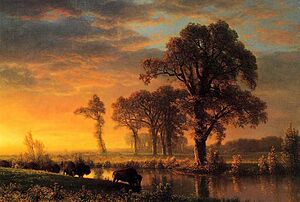
Kansas is home to a number of art museums. The Wichita Art Museum collection focuses on American art. The Nerman Museum of Contemporary Art in Overland Park exhibits artists of national and international recognition. The Spencer Museum of Art, at University of Kansas in Lawrence, has a diverse permanent collection.
Kansas in Film and Television
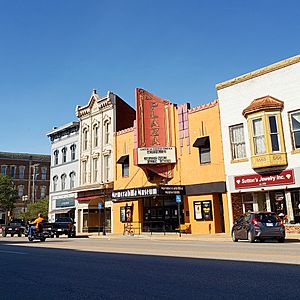
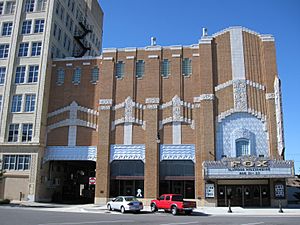
The first film theater in Kansas was the Patee Theater in Lawrence. Most theaters at the time showed films as part of vaudeville acts. The Patee Theater was one of the first of its kind west of the Mississippi River. The Plaza Cinema in Ottawa, Kansas, was built on May 22, 1907. It is listed by the Guinness Book of World Records as the oldest operating cinema in the world. In 1926, The Jayhawk Theatre, an art-deco movie house in Topeka, opened. Today, it shows independent films and hosts plays and concerts. The Fox Theater in Hutchinson was built in 1930 and still plays movies.
- As was the case with the novel, Dorothy Gale (portrayed by Judy Garland) in the 1939 fantasy film The Wizard of Oz was a young girl who lived in Kansas. The line, "We're not in Kansas anymore", is a famous saying.
- The 1967 feature film In Cold Blood, like the book, was set in Kansas. Many scenes were filmed at the exact locations where the events took place.
- The 1988 film Kansas starred Andrew McCarthy and Matt Dillon.
- The 2005 film Capote showed the author traveling across Kansas while writing In Cold Blood.
- The setting of The Day After, a 1983 made-for-television movie about a fictional nuclear attack, was the city of Lawrence.
- Because the super hero Superman grew up in the fictional Smallville, Kansas, multiple films featuring him have been set in Kansas. These include Superman (1978) and Man of Steel (2013).
- The 2012 film Looper is set in Kansas.
- The 1973 film Paper Moon was based in and filmed in Kansas.
- Scenes of the 1996 film Mars Attacks! took place in the fictional town of Perkinsville. Scenes in Kansas were filmed in Burns, Lawrence, and Wichita.
- The 2007 film The Lookout is set mostly in Kansas.
- The 2017 film Thank You for Your Service is primarily set in Kansas.
- The 2019 film Brightburn took place in the fictional town of Brightburn, Kansas.
Television Shows Set in Kansas
- The main characters of the 2005 TV show Supernatural are from Lawrence, Kansas.
- Most of the second season of the TV Series Prison Break had scenes that took place in Kansas.
- The 2006 TV series Jericho was based in the fictional town of Jericho, Kansas.
- Early seasons of Smallville, about Superman as a teenager, were based in a fictional town of Smallville, Kansas.
- Gunsmoke, a radio and television series, took place in Dodge City, Kansas.
- The 2009 Showtime series United States of Tara is set in Overland Park, a suburb of Kansas City.
Sports in Kansas
Professional Sports Teams

| Team | Sport | League | City |
|---|---|---|---|
| Sporting Kansas City | Soccer | Major League Soccer | Kansas City |
| Sporting Kansas City II | Soccer | MLS Next Pro | Kansas City |
| Kansas City Monarchs | Baseball | American Association | Kansas City |
| Garden City Wind | Baseball | Pecos League | Garden City |
| Kaw Valley FC | Soccer | USL League Two | Lawrence, and Topeka |
| Salina Liberty | Indoor football | Champions Indoor Football | Salina |
| Southwest Kansas Storm | Indoor football | Champions Indoor Football | Dodge City |
| Topeka Tropics | Indoor football | Champions Indoor Football | Topeka |
| Wichita Thunder | Ice hockey | ECHL | Wichita |
| Wichita Wind Surge | Baseball | Double-A Central | Wichita |
Sporting Kansas City, a professional soccer team, has played their home games at Village West in Kansas City since 2008. In 2011, the team moved to their new stadium, Children's Mercy Park.
Historically, Kansans have supported the major league sports teams of Kansas City, Missouri. These include the Kansas City Royals (baseball) and the Kansas City Chiefs (football). Their home stadiums are a few miles from the Kansas border.
Two major auto racing facilities are located in Kansas. The Kansas Speedway in Kansas City hosts races from NASCAR and IndyCar. Also, the National Hot Rod Association (NHRA) holds drag racing events at Heartland Park Topeka.
History of Professional Sports in Kansas
The history of professional sports in Kansas likely began with minor league baseball teams in 1886. The Topeka Capitals and Leavenworth Soldiers played in the Western League. In 1887, the Topeka team, called the Golden Giants, was very strong. They won their league and even beat the defending World Series champions, the St. Louis Browns.
The first night game in professional baseball history was played in Independence, Kansas, on April 28, 1930. The Muscogee (Oklahoma) Indians played against the Independence Producers.
College Sports in Kansas
Many Kansans are fans of the state's major college sports teams. These include the Jayhawks of the University of Kansas (KU) and the Wildcats of Kansas State University (KSU). The teams are rivals in the Big 12 Conference.
Both KU and K-State have strong men's basketball programs. The Jayhawks are a top national team, ranking first in all-time victories among NCAA programs. The Jayhawks have won six national titles, including NCAA tournament championships in 1952, 1988, 2008, and 2022. K-State also had a long history of basketball success, making four Final Four appearances.
In football, both KSU and KU have had recent successes. The Jayhawks won the Orange Bowl in 2008, finishing with a 12–1 season. When Bill Snyder became coach at K-State in 1989, he turned the Wildcats into a national force. The team won the Fiesta Bowl in 1997 and the Big 12 Conference championship in 2003 and 2012.
Wichita State University also has teams (called the Shockers) in Division I. They are best known for their baseball and basketball programs. In baseball, the Shockers won the College World Series in 1989. In men's basketball, they appeared in the Final Four in 1965 and 2013.
NCAA Division II Schools in Kansas
Smaller schools in Kansas have also achieved notable success in football. Pittsburg State University, an NCAA Division II participant, has claimed four national titles in football. They won the 2011 NCAA Division II national title. Pittsburg State became the winningest NCAA Division II football program in 1995.
Washburn University, in Topeka, won the NAIA Men's Basketball Championship in 1987. The Fort Hays State University men won the 1996 NCAA Division II title with a 34–0 record. The Washburn women won the 2005 NCAA Division II crown.
Junior Colleges in Kansas
The Kansas Jayhawk Community College Conference is known as one of the best conferences in NJCAA football. Teams like Garden City Community College, Independence Community College, and Butler County Community College are often competing for national championships.
High School Sports in Kansas
The Kansas State High School Activities Association (KSHSAA) oversees sports and other competitions for high schools in Kansas. It sponsors championships in many sports and activities.
Images for kids
-
Samuel Seymour's 1819 drawing shows a Kansa lodge and dance. It is the oldest known drawing from Kansas.
-
The Great Plains of Kansas
-
Spring River, Kansas
-
Climate types of Kansas.
-
Kansas's Monument Rocks at night
-
The Rio Theatre, Overland Park
-
The Plaza Cinema in Ottawa is the oldest operating movie theater in the world.
-
Fox Theater, Hutchinson
-
Children's Mercy Park, Kansas City
-
Allen Fieldhouse at University of Kansas in Lawrence
-
Tyler Field in Eck Stadium at Wichita State University in Wichita
See also
 In Spanish: Kansas para niños
In Spanish: Kansas para niños



